
December 17, 2009.
Travelling up or down Dominica’s mountainous roads on foot is not easy. Then again, travelling in a car is not particularly easy either. For the human body, heat is the main factor. Asphalt at noon is unbearable and the climb is steep. That I arrived at every destination, repeatedly, and without ever passing out is still a happy mystery to me.
Note: I write about transportation for a number of paragraphs. Skip below to the header, “Don’t Go Chasing Waterfalls” if you want to jump straight to the rainforest hike portion of this day.
Vehicles must traverse these same roads, roads that are so narrow that it seems like magic when two vehicles manage to pass without a collision. And then there are the switchbacks. Experienced drivers here know to pull to the side and honk their horn at the start of a switchback. You can’t see who may be coming down or up, and with the roads being as narrow as they are, its the only way to safely traverse the curves without running the risk of crashing into a vehicle coming in the opposite direction. An accident here is not an accident in a city like Toronto where there’s help and any number of hospitals close by. There are few hospitals on the island. Emergency services are limited. Getting to you could take time, that’s if you don’t go over a cliff, which are terrifying drops into nothingness, and virtually everywhere.
I don’t recall seeing many railings. Much of the roadsides are open with a wall of monstrous bamboo plants and trees shielding your sightline from the reality of what lies below. The few times we drove in areas where the plants had been cleared were absolutely petrifying. I could barely look when walking, but moving fast in a vehicle… who needs a Six Flags coaster when the all too real thing is your everyday? I preferred to look down when driving through those open areas, willing my overactive nervous system to believe this was no big deal. Fortunately, I was not the one driving. We left that to those with experience. I would never rent a car there. Absolutely no way. In fact, a car went off a cliff in the weeks we were there. Two lives lost instantly.

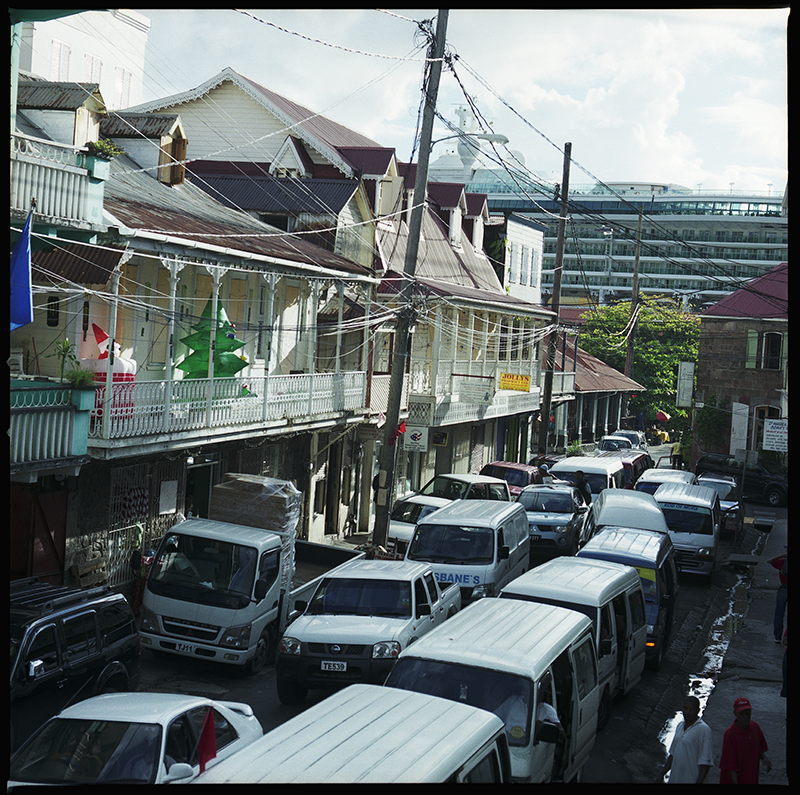
Enormous cruise ship versus the capital city of Roseau.
Now circling back… imagine being a pedestrian on these roads. Imagine traversing these bends at night with only the moon’s glow to guide you. And cars with only their headlights as illumination. Being near to the equator meant that the sky turned dark like clockwork at 6pm every night. We always aimed to be walking back by 4 at the latest, but unfortunately there were some exceptions, which I will get to later.
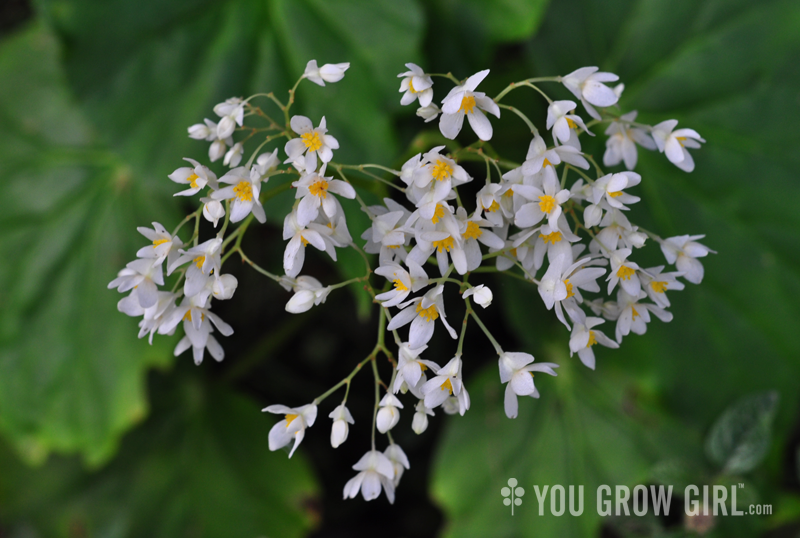
White-flowered begonia.

Dominica is a volcanic island and there are a lot of sulphur springs in the Morne Trois Pitons area specifically. You could really see the steam when you went up into the mountains, but it sometimes moved down from the mountains as well. We smelled sulphur constantly for nearly the entire 3 weeks we were in Dominica. The following week of the trip was spent in the area around Soufriere in St. Lucia and we smelled sulphur there too. It felt weird to return home after a month and NOT smell rotten eggs in the air. That said, this could also be steam from The Boiling Lake, which is nearby.
On this particular day, our goal was to go up into the mountains to Morne Trois Pitons National Park, a UNESCO World Heritage Site. This is an incredible place. It is also vast with a long selection of magical landscapes to explore. We chose Middleham Falls as our first excursion, in part, if I am remembering correctly, because it felt like a good introductory hike. An intermediate rainforest path we could traverse without a guide. Dominica boasts 365 rivers, one for every day, and 12 waterfalls. This would be our first.
But first we had to get there.
I’ve briefly mentioned our experience with the bus system before. We’d only taken public buses in Barbados, and while it was not convenient and there were some uncomfortable and even dramatic moments, overall it was doable. But Barbados is a flat coral island with a larger population. Working from our friend Paul Crask’s excellent guidebook to Dominica, we had some idea of what to expect here, including the complexity and inconsistency of the so-called system. This is a small but mountainous volcanic island with a small and spread-out population — public services are what they are.
We headed to the spot in town (population around or even less than 10,000 at the time) where we believed there was a bus stop. And then we waited. The thing is, at least at the time, there were no signs or special booths indicating bus stops. It all seemed to be based on insider knowledge, information that can change. After some time we realized our pseudo-intel was off and started asking people working in nearby businesses if they knew if we were waiting in the right spot and when the next bus was scheduled to pass. Unfortunately, we looked like tourists, because we were, and so people likely thought we were asking after the tourist van system, which is exponentially more costly, but equally more convenient. Incidentally, the tourist vans look pretty much like the public bus system vehicles, which are also vans. Several tourist vans stopped to offer us a ride while we waited, but we were stubbornly insistent that we were in the know and just had to be patient. The same thing happened in Barbados, and sure, it got to be disconcerting out in the middle of nowhere without food or a telephone and the night creeping in, but that had worked out. This would too, dammit.
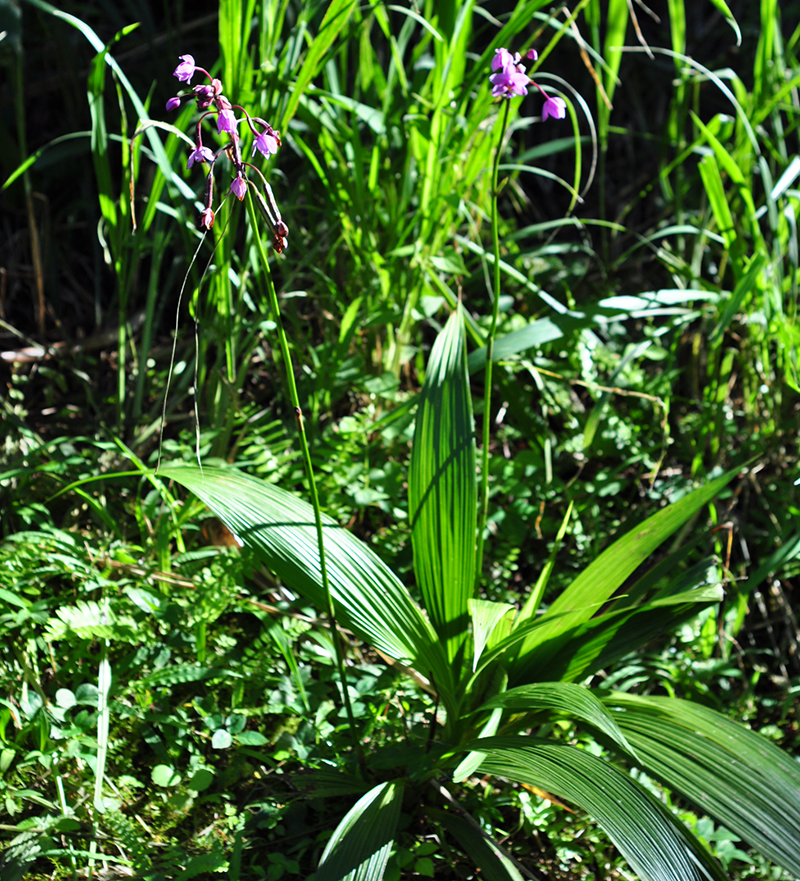
David’s orchid (Spathoglottis plicata)
The other thing to remember is that in general, people around the world don’t really like to pass along bad news to strange tourists. I found that in Dominica particularly, people wanted to be helpful, almost to a fault, because sometimes helpfulness meant leaving out negative, but vital information. So every time we asked a local about the bus, the general response was an optimistic, “Soon come.” We got the same response repeatedly in Barbados, too, and again, that had worked out. It was impossible to tell which way this was going to go, but at least we were in town, carrying food and water, and not far from our little cottage. Of course, they were likely also expecting us to be waiting for a tourist van and were probably confused each time we waved one off.
After about an hour standing on the hot sidewalk bewildered and frustrated, a friend of ours drove past. This is a small island. I can’t tell you how many times we bumped into people spontaneously in this way. I don’t run into friends this often here at home, not even with those who live directly across the street. She stopped and confirmed what I was already starting to expect. Public buses usually run only a few times per day: primarily in the mornings to bring folks into the city for work, and back out at the end. Where we were going was even further up into the mountains and there would be no more buses out that day. I was very nervous about spending cash on this trip. We had saved money, but it wasn’t a lot and it had to last an entire month. But with no other option, we decided to risk it and hailed the next tourist van that came by.
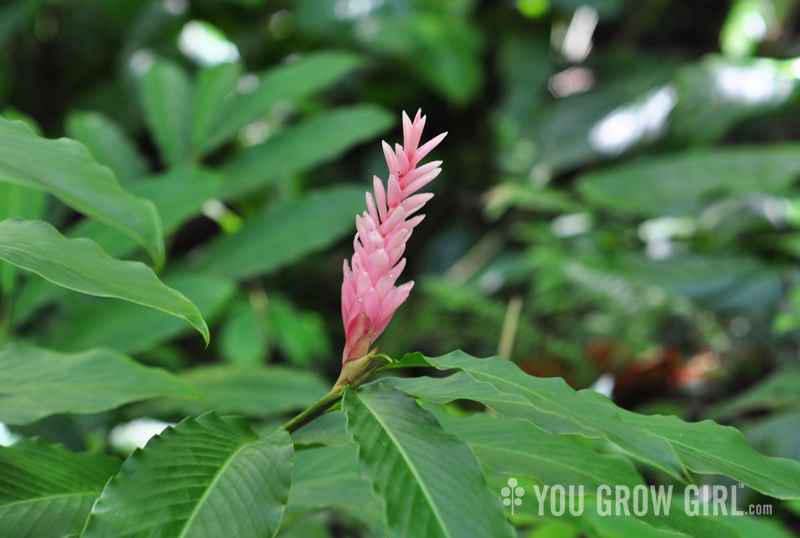
Alpinia A ginger family plant.

Episcia with purple flowers. A member of the Gesneriaceae family, related to African violet. I think that might be a Pilea in the back right, member of the Urticaceae family (same family as stinging nettle). Either that or it is a type of nettle.
There are two things I learned on this trip that I would do differently in the future. The first is budget more money for transportation than you’d expect. Getting around is complicated, especially during the holiday season. It would be a shame to miss visiting sights you may never have the opportunity to see again simply because you could’t figure out how to get there. The second is to hitch rides. It hasn’t been considered safe to do that here in North America since the seventies, and so it never even occurred to me to try. But in a place where public transport is sparse and many do not own vehicles, giving pedestrians a lift is just a part of the social contract and most people are happy to take you up the road in the back of their pickup trucks. As a thank you, I’d suggest offering some money to help with gas or something else in trade. Later in the trip a friend’s aunt traded me for a massive piece of thick cinnamon bark that someone had given her in exchange for a ride.
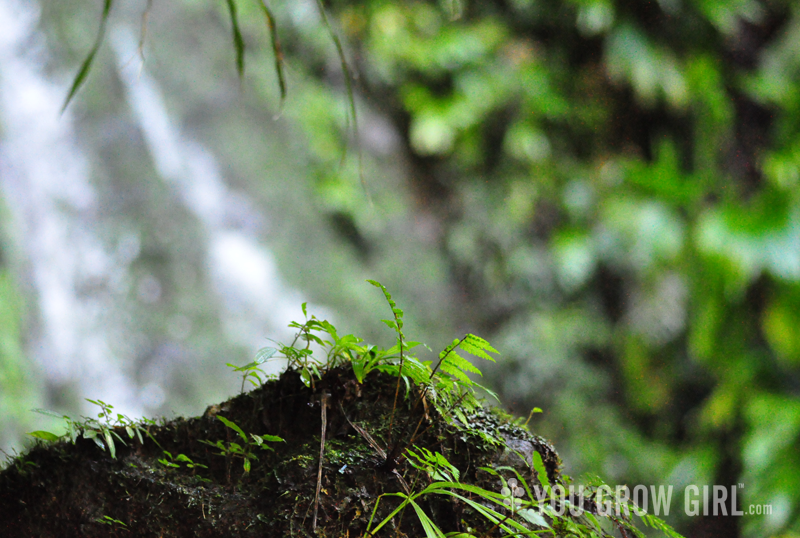

A waterfall at Middleham Falls that isn’t the actual falls. A lesser falls, if you will. Alas, this was the closest to the falls that we got, which was really not a concession prize given their beauty. Despite the abundance of waterfalls on the island, we did not have a lot of luck seeing them. Well, not the big and best ones, anyways. This theme will come up a number of times as I review the days of this trip.
Don’t Go Chasing Wterfalls
Paying extra for a tourist van came with the convenience of being dropped off directly inside the park. Had we taken the regular bus, we likely would have had to walk the hot asphalt road from nearest town, Laudat. The entrance to the park was empty. There were no rangers, no cars, no other visitors. We had planned for this. And while we did have a cellphone that we’d purchased locally, we were fairly certain that service would drop off eventually. For this reason we planned to be more careful than usual: no pushing ourselves too hard and no going off trails. I carried emergency supplies in my camera bag, and we’d packed a lunch and plenty of water, although on Dominica, much of the flowing water in the mountains is drinkable.
After consulting the information booth and maps, we hit the trail.
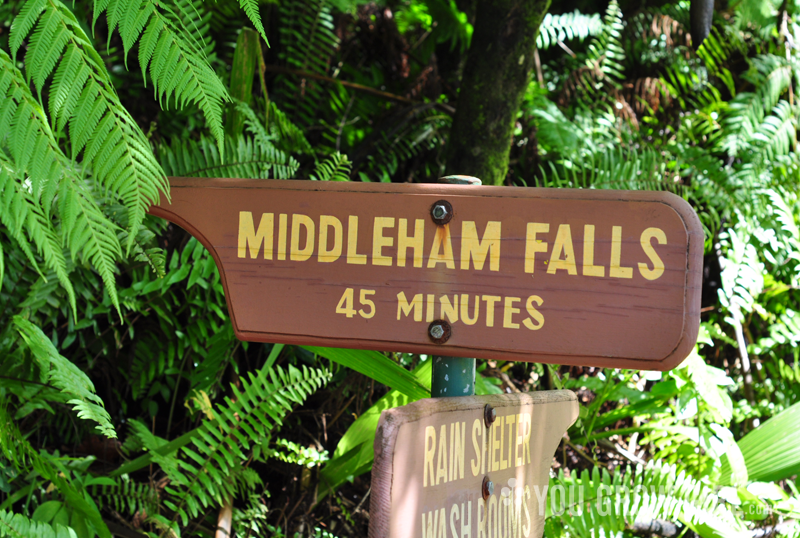
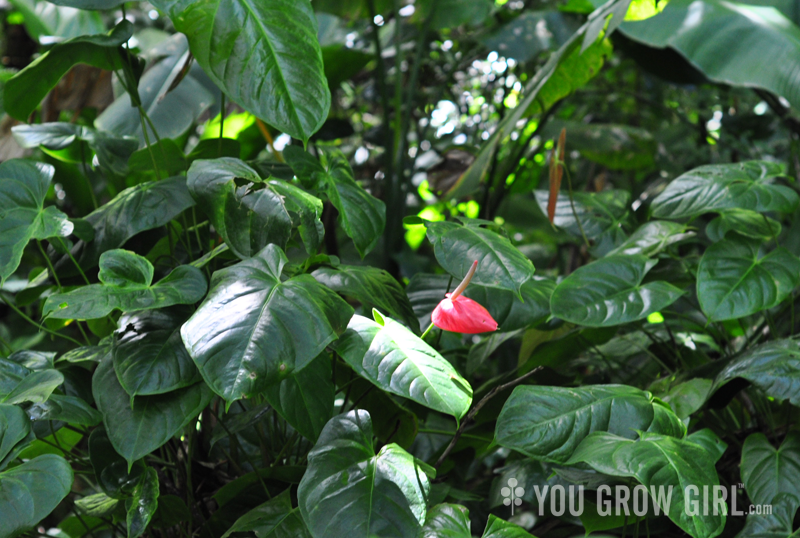
A rather large and gorgeous Anthurium. Until this trip, I’d always found Anthuriums to be rather tacky plants. Especially those phallic looking flowers. But seeing them growing wild, in their full majesty, completely changed my perspective. Even the leaves themselves are quite beautiful.
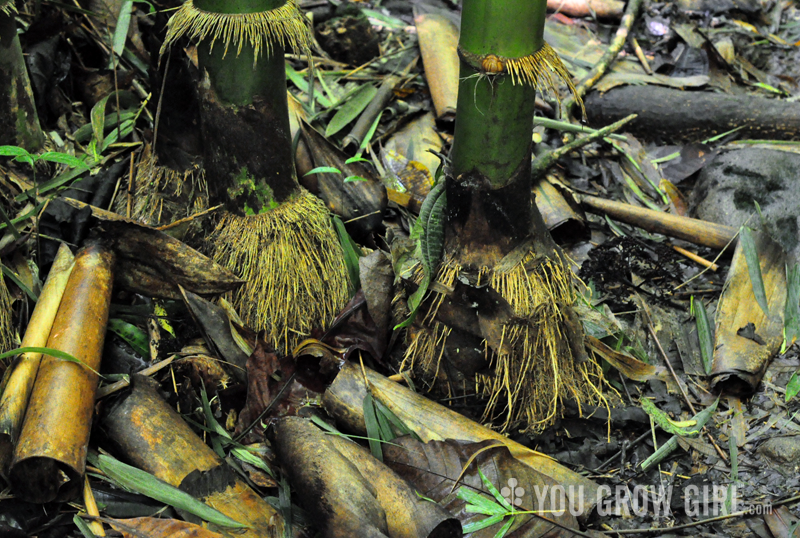
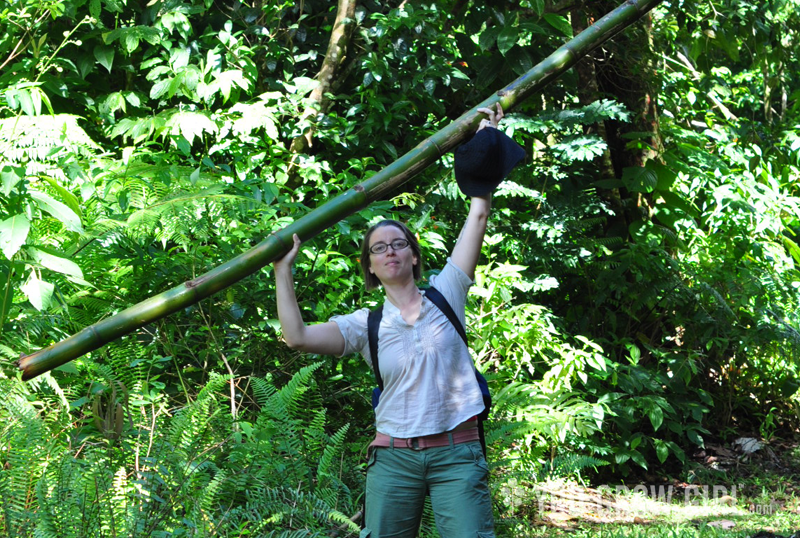
Bamboo in Dominica was the largest I have ever seen. This was by no means the largest. Some of the stalks I saw were as thick as an arm.
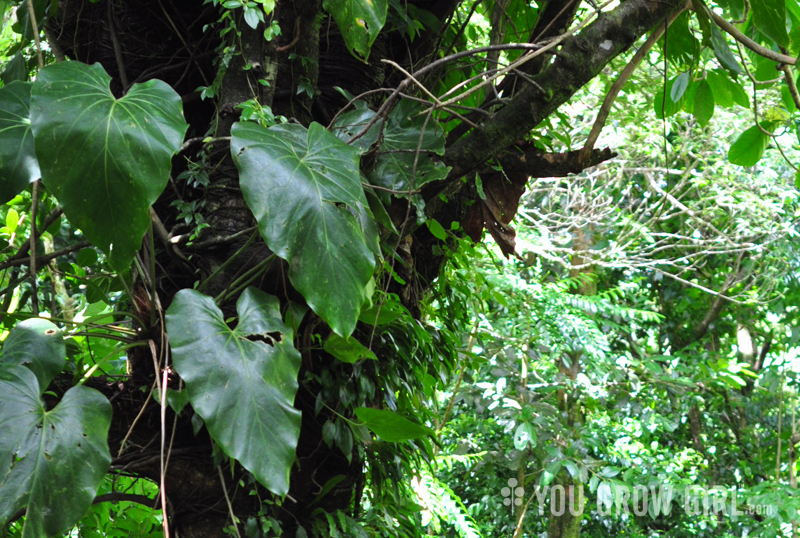
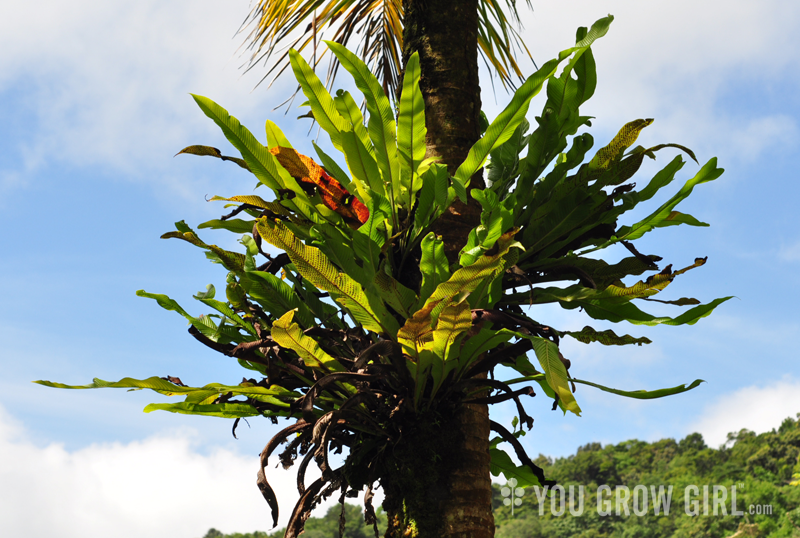
Bird’s Nest Anthurium (Anthurium hookeri). This plant was posted on the park’s information boards as one of the plants to see in the area. I agree, they were pretty cool.
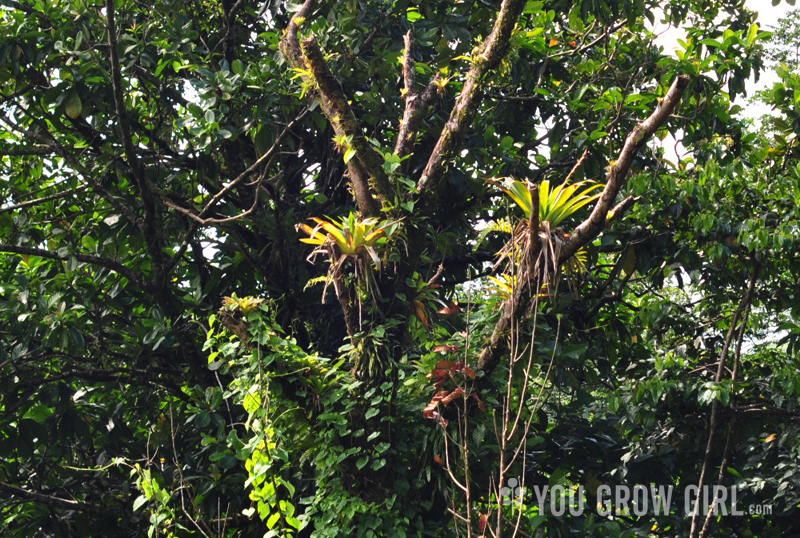
Large bromeliads up in the trees. I was even more taken by these than the Anthuriums.
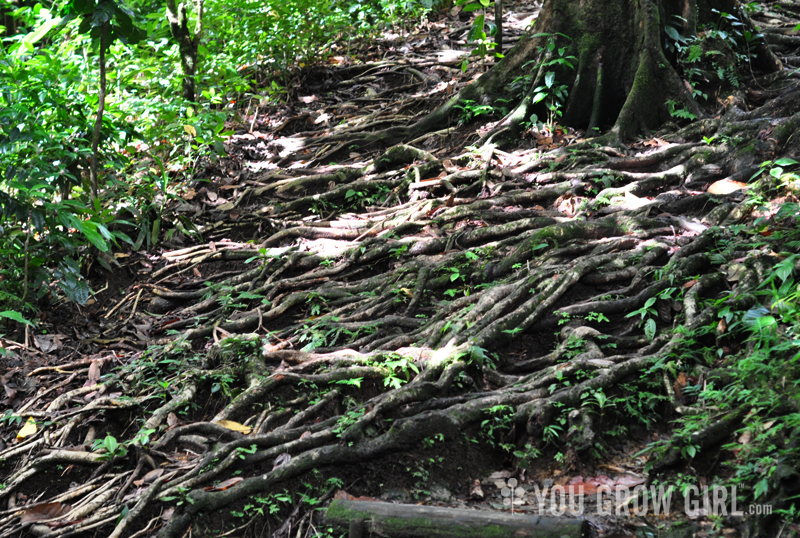
Gorgeous Chataignier (Sloanea sp.) roots. These are very large and old tree species with beautiful trunks that form buttresses near the base.
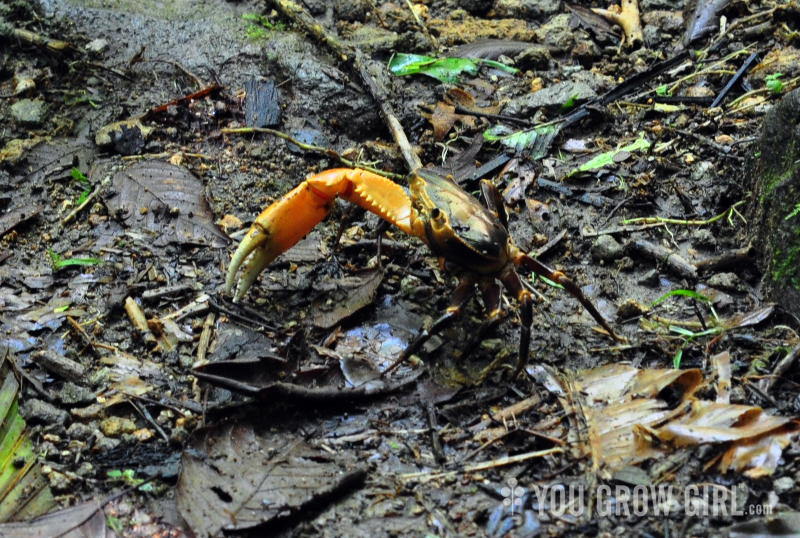
In the novel, Wide Sargasso Sea, set in part in Dominica, the island’s most famous writer, Jean Rhys, describes the landscapes, flora, and fauna of Dominica through the eyes of the protagonist, Antoinette Cosway. One passage that stood out to me so long ago when I first read the novel, was a description of land or river crabs aka cyrique (Guinotia dentate), brightly-coloured crabs that live in the jungle and freshwater rather than by the sea. When I first came upon this part of the book I was immediately intrigued, so when we talked about visiting the island, they were up at the top of things I HAD to see. As we set out on the rainforest path toward Middleham Falls, I scanned the moist ground for crabs rather than training my eyes around at plant life or up at the trees, which is my usual way. Wouldn’t you know it, shortly after moving out of the brighter edges of the forest and traveling into the darker, denser foliage, we crossed paths with our first. He stood right there in front of me, waving his over-sized, bright orange claw threateningly, as if he were a match for my size. In the book they are described as dangerous, but that’s simply not true. They may be defensive when taken off-guard, but are far more likely to run when they see you. Wouldn’t you be a bit defensive too if you were a tiny little creature suddenly faced by a giant? He quickly scrambled into the moist forest bush and was gone. And I cried a little, joyful in having seen this gorgeous creature first-hand on the land of my people. It was a meaningful moment. There would be many more like this to come.

A typical scene along the trail. It was quite wet and there were a few spots where we had to remove our shoes and wade through a stream to continue along the path.
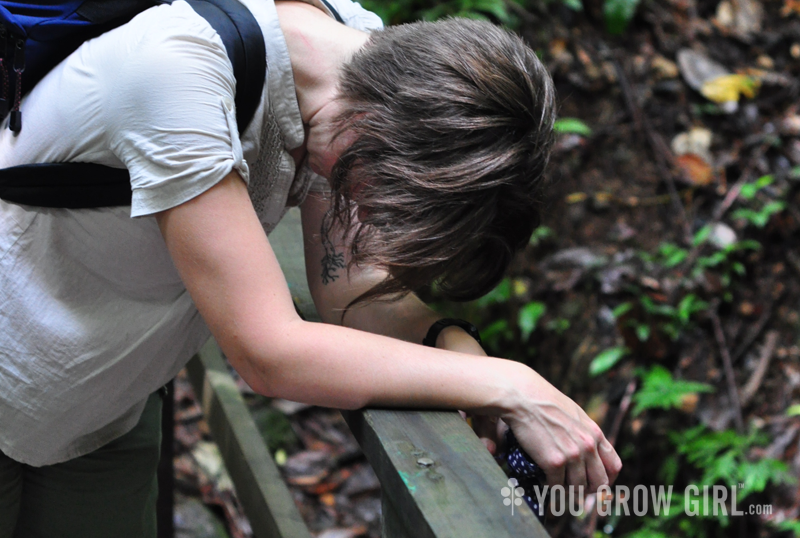
Only about halfway there and already sweating bullets. Dominica is humid everywhere. But the rainforest is another level. Thankfully this water crossing had a bridge.
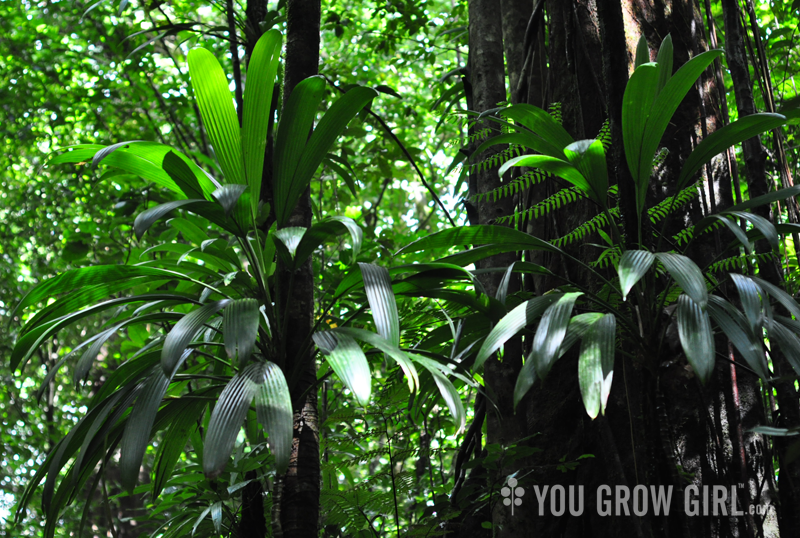

We reached these falls excitedly, realizing that we were likely close to our destination, which were touted to be much larger falls with a big pool.
Once we reached Not Middleham Falls, we hit the end of the path. It just stopped abruptly. We could see below, through the trees, that there was something else beyond, but there was no obvious or safe way to get there. Later, after consulting with our friend Paul, we believe there had been a mudslide, washing the trail out entirely. Being alone in the middle of nowhere where the cliffs are steep and the ground is moist and slippery, we decided to give up trying to find the real Middleham Falls, and instead put on our bathing suits (not that they were needed since we never came upon another human in this part of the park), and plopped ourselves into the cool and refreshing waters of a small pool. We’d already been hiking for an hour and this seemed like a good place to break. The pool was basically just above the path, and I suspect that it is not there year-round, but a part of the washout. To be honest, it felt rough and precarious even there. The rocks were slippery and the waterfall above was intense. I shot a video at the time and watching it again, the sound of the spraying, crashing water was something else. Deciding to call it quits here was a smart choice. Once situated, we took out our food and enjoyed lunch while sitting below this gorgeous waterfall, in the middle of a rainforest. It was decadent and lush. I’ll never forget that simple, yet exquisite meal!

I took this photo while sitting in the pool.

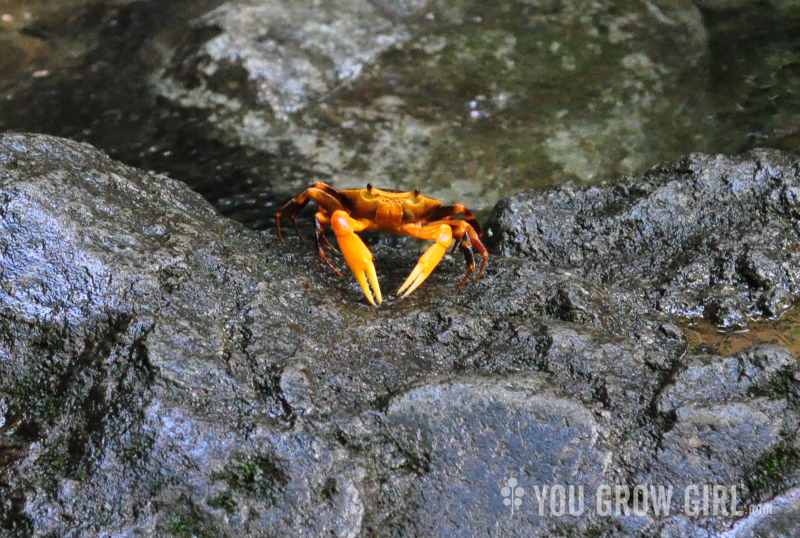
We were soon joined by what I believe to be a female land crab. She was not threatening, just curious, and we shared a small piece of chicken with her. They’re mostly carnivorous, although I suspect chicken is not in their natural diet. So now I’ve just admitted to feeding the wildlife, but in my defence, the chicken was boiled and plainly prepared and not like the battered and fried KFC snack packs seagulls and squirrels picked out of the garbage cans on my former University’s campus.
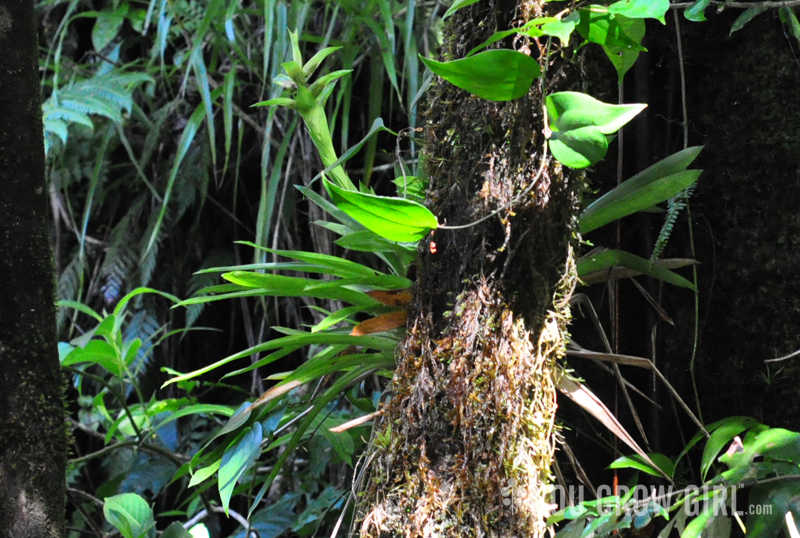
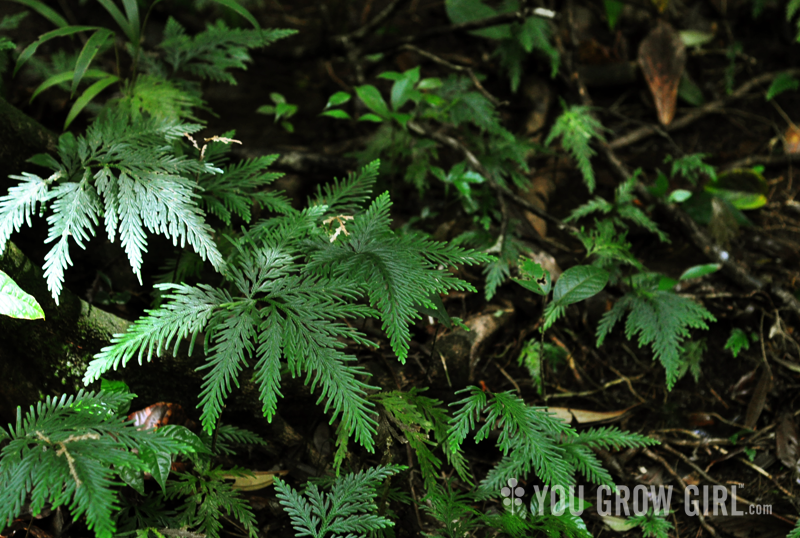
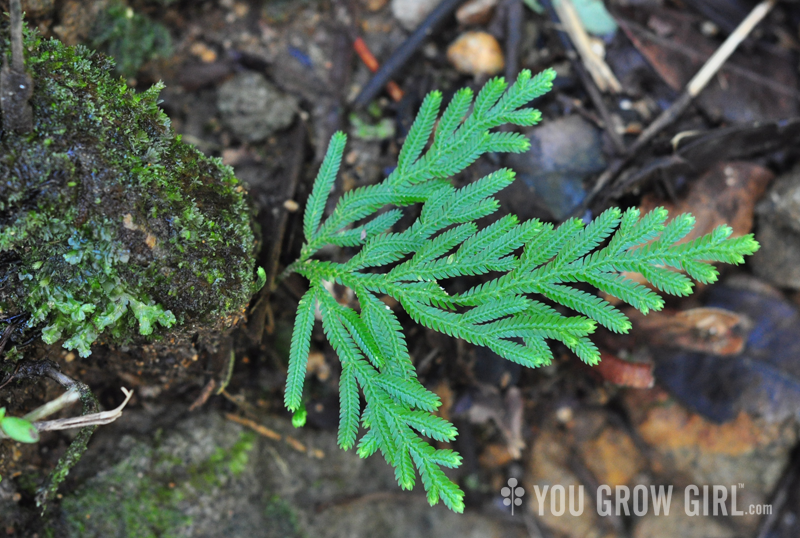
Spikemoss (Selaginella sp.). Selaginella were a common sight on this trip. I spotted several different species growing out of embankments and mud walls.
Once we left the park, we headed uphill to the town of Laudat, as this seemed like our best bet for finding a ride back to Roseau. As luck would have it, we didn’t have to go too far before we caught another tourist van.

Check out the tree fern decorated with red ribbons. While it was the Holiday season, a major election was happening in the country, and the ribbons were actually representative of one of the parties. Davin is looking very sweaty here. We were on asphalt in full sun. Blessedly, there is no photographic evidence of me taken at this time.
It is not uncommon in Dominica to come upon naturally created living walls. As we walked the hot road to Laudat, I took the opportunity to capture some of the flora holding together what are little more than precarious walls of mud and rock. As you can imagine, landslides are also not uncommon on the island.
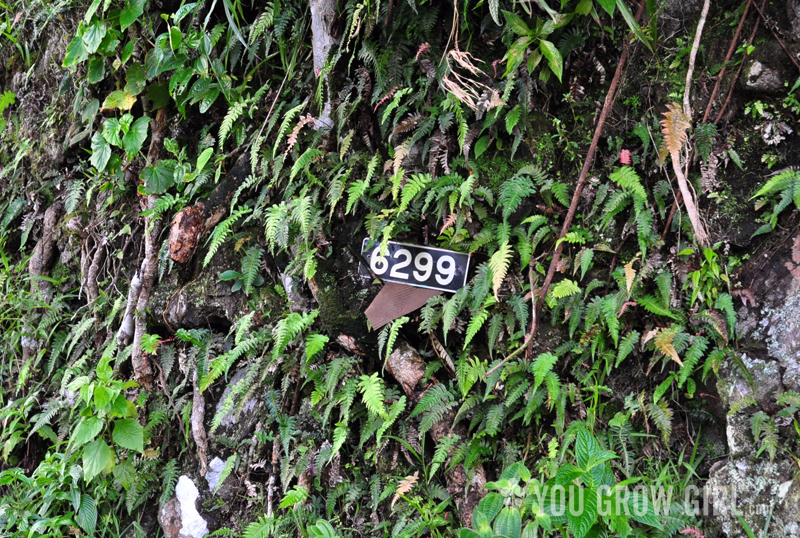

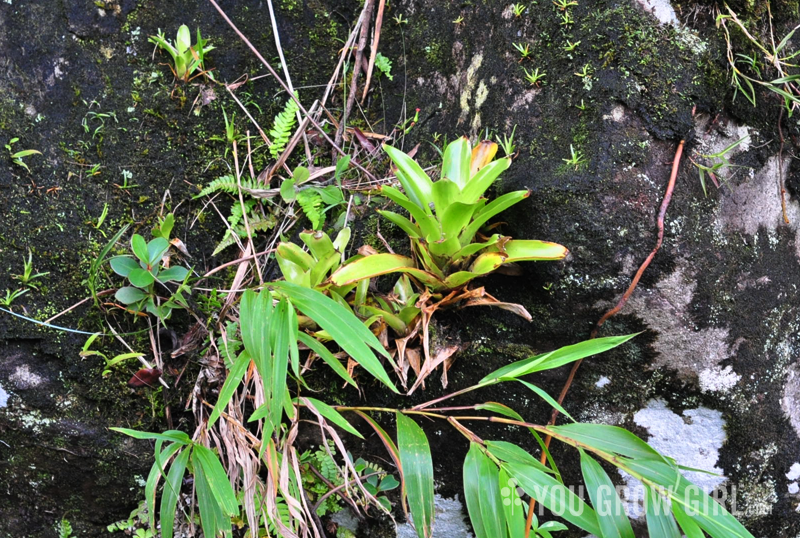


This is Davin holding the takeout dinner we purchased in Roseau before the uphill hike back to the cottage. He looks pretty out of it, because he was. It had been a long, intense day. We walked this road countless times over the span of 3 weeks. For the record, this is the flat part before the real hills begin.

I took a pinhole photo of us most days of the trip. This was the photo taken on the morning of Day 11, before we set out for the day. You can tell it was the morning because we’re not yet drenched in sweat!